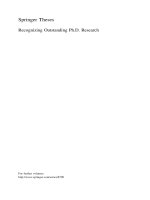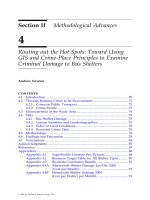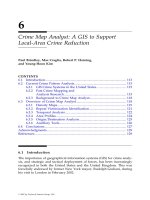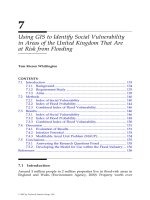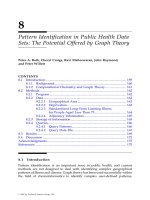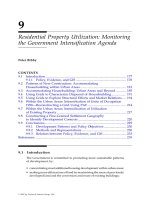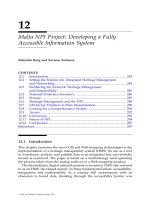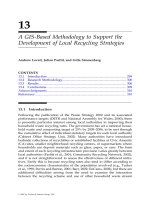Binary metal oxide and polymer based liquid repellent self cleaning surfaces
Bạn đang xem bản rút gọn của tài liệu. Xem và tải ngay bản đầy đủ của tài liệu tại đây (5.64 MB, 184 trang )
BINARY METAL OXIDE AND POLYMER BASED
LIQUID REPELLENT SELF-CLEANING SURFACES
ANAND GANESH VENKATESAN
NATIONAL UNIVERSITY OF SINGAPORE
2014
BINARY METAL OXIDE AND POLYMER BASED
LIQUID REPELLENT SELF-CLEANING SURFACES
ANAND GANESH VENKATESAN
(B. Eng.) Anna University, Chennai - India.
A THESIS SUBMITTED
FOR THE DEGREE OF DOCTOR OF PHILOSOPHY
DEPARTMENT OF MECHANICAL ENGINEERING
NATIONAL UNIVERSITY OF SINGAPORE
2014
DECLARATION
I hereby declare that this thesis is my original work and it has been written by me
in its entirety. I have duly acknowledged all the sources of information which
have been used in the thesis.
This thesis has also not been submitted for any degree in any university
previously.
Anand Ganesh Venkatesan 10
th
June 2014
i
ACKNOWLEDGEMENTS
In the first place I would like to express my heartfelt gratitude to Professor
Seeram Ramakrishna for his supervision, advice, guidance from the very early
stage of this research and also for providing me an excellent atmosphere for doing
the research. His continuous encouragement in various ways inspired me and
enriched my growth as a research student.
It is a pleasure to thank my advisor and friend Professor A. Sreekumaran
Nair for his incessant support, patience, encouragement and his willingness to
share his thoughts with me, which was very fruitful for shaping up my ideas and
research.
I am grateful to Dr. Saifullah for his support and guidance in this research.
His knowledge and involvement in research has triggered and nurtured my
intellectual maturity that I will benefit from, for a long time to come.
I will forever be thankful to Dr. Sundaramurthy, Dr. Radhakrishnan
Sridhar, Dr. Murugan, Dr. Venugopal and Dr. Molamma for teaching me new
scientific concepts and polymer chemistry. The knowledge that I imparted from
them helped me to formulate new ideas and assisted me to advance further in my
research.
Many thanks to Dr. Timothy Michael Walsh for his excellent guidance
and valuable advice in scientific discussions and furthermore, spending his time in
showing and explaining the entire process involved in the fabrication and
installations of huge solar modules.
ii
I would like to dedicate this thesis to my beloved parents and my lovely
brother. Without my parents’ blessings and moral support, I don’t think I could
have completed my PhD Studies. Thank you mom and dad!!! I love you and am
forever indebted to you for giving me life and your love.
I would like to convey special thanks to my friends Saman, Hemant,
Naveen and Rajeswari for their continuous encouragement and support in my
experiments and useful technical discussions that helped me to shape my research
in a better way.
I gratefully acknowledge PhD Research Scholarship from National
University of Singapore for financially supporting my entire PhD Studies.
My time at Singapore was made enjoyable in large part due to my roomies
who became a part of my life. I am grateful to all my roomies (Satheesh, Rohit,
Suresh, Vinoth, Prasanna and Jagadeesh) for their moral support in difficult times
of my life.
Lastly, I would like to thank the Almighty for giving me wonderful
parents, teachers and friends. They all made my life very pleasant and enjoyable.
iii
LIST OF PUBLICATIONS
1. Direct electrospraying of lubricating material to fabricate robust and
highly transparent omniphobic surfaces.
V. Anand Ganesh, Saman Safari Dinachali, Radhakrishnan Sridhar,
Hemant Kumar Raut, Aleksander Góra, Avinash Baji, A. Sreekumaran
Nair and Seeram Ramakrishna. Submitted to Advanced Materials
Interfaces.
2. Robust Superamphiphobic Film from Electrospun TiO
2
Nanostructures.
V. Anand Ganesh, Saman Safari Dinachali, A. Sreekumaran Nair and
Seeram Ramakrishna. ACS Applied Materials & Interfaces, 2013, 5,
1527-1532.
3. Electrospun SiO
2
nanofibers as a template to fabricate a robust and
transparent superamphiphobic coating.
V. Anand Ganesh, Saman Safari Dinachali, Hemant Kumar Raut,
Timothy Michael Walsh, A. Sreekumaran Nair and Seeram
Ramakrishna. RSC Advances, 2013, 3, 3819-3824.
iv
4. Superhydrophobic fluorinated POSS-PVDF-HFP nanocomposite
coating on glass by electrospinning.
V. Anand Ganesh, A. Sreekumaran Nair, Hemant Kumar Raut, Tristan
Tsai Yuan Tan, Chaobin He, Jianwei Xu and Seeram Ramakrishna.
Journal of Materials Chemistry, 2012, 22, 18479-18485.
5. Photo-catalytic Superhydrophilic TiO
2
Coating on Glass by
Electrospinning.
V. Anand Ganesh, A. Sreekumaran Nair, Hemant Kumar Raut,
Timothy Michael Walsh and Seeram Ramakrishna. RSC Advances,
2012, 2, 2067-2072.
6. A review on self-cleaning coatings.
V. Anand Ganesh, Hemant Kumar Raut, A. Sreekumaran Nair and
Seeram Ramakrishna. Journal of Materials Chemistry, 2011, 21,
16304-16322.
7. Anti-reflective coatings: A critical, in-depth review.
Hemant Kumar Raut, V. Anand Ganesh, A. Sreekumaran Nair and
Seeram Ramakrishna. Energy & Environmental Science, 2011, 4, 3779-
3804.
v
8. Robust and durable polyhedral oligomeric silsesquioxane-based anti-
reflective nanostructures with broadband quasi-omnidirectional
properties.
Hemant Kumar Raut, Saman Safari Dinachali, Ai Yu He, V. Anand
Ganesh, M.S.M. Saifullah, Jaslyn Law and Seeram Ramakrishna.
Energy & Environmental Science, 2013, 6, 1929-1937.
9. Porous SiO
2
Anti-reflective Coatings on Large-area Substrates by
Electrospinning and their Applications to Solar Modules.
Hemant Kumar Raut, A. Sreekumaran Nair, Saman Safari Dinachali,
V. Anand Ganesh, Timothy Michael Walsh and Seeram Ramakrishna.
Solar Energy Materials and Solar Cells, 2013, 11, 9-15.
10. Fabrication of highly uniform and porous MgF
2
anti-reflective coatings
by polymer-based sol-gel processing on large-area glass substrates.
Hemant Kumar Raut, Saman Safari Dinachali, Kwadwo Ansah Antwi,
V. Anand Ganesh and Seeram Ramakrishna. Nanotechnology, 2013,
24, 505201.
vi
TABLE OF CONTENTS
List of Tables xiii
List of Schemes xv
List of Figures xvi
List of Abbreviations xxiv
Chapter 1 – Introduction 1
1. Background and motivation 2
2. Scope and research objective 5
3. Dissertation outline 6
4. Key research contributions 8
Chapter 2 – Literature review 9
1. Introduction 10
2. Self-cleaning effect 11
3. Wetting theories 12
3.1 Roughness parameters 15
4. Hydrophobic and superhydrophobic coatings 17
4.1 Nature’s lead 17
4.1.1 Plant leaves with hierarchical structure 18
4.1.2 Plant leaves with unitary structure 20
4.2 Mechanisms to produce superhydrophobic coatings 21
vii
5. Functions of hydrophobic surfaces 34
5.1 Anti-icing 35
5.2 Electrowetting and other functions 36
6. Hydrophilic photocatalytic coatings 38
6.1 Materials and mechanism to produce hydrophilic coatings 38
6.1.1 Titanium dioxide (TiO
2
) 38
6.1.2 Improving TiO
2
41
6.1.3 Improving TiO
2
by doping 42
6.1.4 Other materials 43
6.2 Mechanisms employed to produce hydrophilic coatings 43
7. Recent advancements in self-cleaning coatings 47
8. Characterization techniques 49
9. Applications of self-cleaning coatings 49
10. Conclusion 50
Chapter 3 – Superhydrophobic coating 53
Superhydrophobic coating from electrospun fluorinated POSS-PVDF-HFP
nanocomposite mixture
1. Introduction 54
2. Experimental section 55
2.1 Materials 55
2.2 Synthesis of FPSi8 and FP8 fluoroPOSS 56
viii
2.3 Solutions and substrate preparation 58
2.4 Electrospinning 59
3. Instrumentation and characterization 60
4. Results and discussion 61
4.1 Nanofiber diameter – concentration dependence 61
4.2 Surface energy of the coating 66
4.3 Optical properties 68
4.4 Peel-off and durability tests 69
5. Conclusion 71
Chapter 4 – Amphiphobic coating 73
Electrospraying of lubricating material to fabricate robust and transparent
amphiphobic surfaces
1. Introduction 74
2. Experimental section 76
2.1 Materials 76
2.2 Solution and substrate preparation 76
2.3 Electrospraying 77
3. Instrumentation and characterization 78
4. Results and discussion 79
4.1 Fabrication of amphiphobic surface 79
4.2 Surface energy calculation 88
4.3 Optical properties 89
ix
4.4 Peel-off and durability tests 91
5. Conclusion 92
Chapter 5 – Superamphiphobic coating 94
Superamphiphobic coating from electrospun TiO
2
nanostructures
1. Introduction 95
2. Experimental section 96
2.1 Materials 96
2.2 Solution and substrate preparation 96
2.3 Electrospinning 97
2.4 Chemical vapour deposition of fluorinated silane 98
3. Instrumentation and characterization 99
4. Results and discussion 100
4.1 Fabrication of superamphiphobic surface 100
4.2 Hardness and modulus measurements 107
4.3 Peel-off and durability tests 107
5. Conclusion 109
x
Chapter 6 – Transparent superamphiphobic coating 112
Transparent superamphiphobic coating from electrospun SiO
2
nanostructures
1. Introduction 113
2. Experimental section 114
2.1 Materials 114
2.2 Solution and substrate preparation 114
2.3 Electrospinning 115
2.4 Deposition of triethoxysilane (TS) 116
3. Instrumentation and characterization 117
4. Results and discussion 118
4.1 Fabrication of transparent superamphiphobic surface 118
4.2 Self-cleaning property 126
4.3 Hardness measurement and optical property 126
4.4 Peel-off and durability tests 127
5. Conclusion 129
Chapter 7 – Conclusion and Future work 131
1. Conclusion 132
2. Future work 136
Bibliography 138
xi
SUMMARY
The self-cleaning effect is related to the contact angle - the angle formed
at the three-phase boundary (liquid/solid/vapor) between the surface of a
liquid drop deposited on the surface of a solid. The principle behind this
technology is derived from the behavior of water droplets on the surface of lotus
leaves (“Lotus Leaf Effect”). Self-cleaning coatings are broadly classified into
two major categories: hydrophilic and hydrophobic. Both of the categories clean
themselves by the action of water. In a hydrophilic coating (water contact angle <
90º), water is made to spread (i.e., ‘sheeting’ of water) over the surfaces, which
carries away the dirt and other impurities, while in the hydrophobic technique
(water contact angle > 90º), the water droplets slide and roll over the surfaces
thereby cleaning them. However, the hydrophilic coatings using suitable metal
oxides have an additional property of chemically breaking down the complex dirt
deposits by a sunlight-assisted cleaning mechanism. Both hydrophilic and
hydrophobic surfaces involve the application of nanostructures (metal
oxide/polymer) to achieve the self-cleaning phenomenon.
Recent reports state that by applying new-age functional self-cleaning
coatings on architectural glasses, windows, automobiles and household
applications can collectively contribute to a global market share of about 3.8
billion USD by 2017. However, with the growing industrial demands and the
constant need for eco-friendliness, the present research in self-cleaning coating
technology is primarily focusing on the development of highly durable and
sustainable coatings that can reduce the consumption of resources and
xii
environmental impacts. Nonetheless, implementation of conventional coating
technologies may lead to increase in design complexity and cost. The scalability
of the techniques has also been a challenge.
In this dissertation, simple, cost-effective and scalable nanostructures
fabrication techniques, viz. Electrospinning/Electrospraying, have been
investigated to develop durable, environment friendly, transparent, high
performance liquid repellent (Hydrophobic/Superhydrophobic,
Amphiphobic/Superamphiphobic coatings) self-cleaning coatings. To achieve this
objective, suitable metal oxide and polymer based electrospun/electrosprayed
surfaces have been developed and the self-cleaning attributes along with the
optical and mechanical properties of the fabricated surfaces were thoroughly
studied. Furthermore, the mechanism leading to the surface morphology and
surface modifications that are performed to enhance the self-cleaning
performance parameters have also been studied and analyzed.
The final outcome of the thesis is to draw a comparison between various
liquid repellent (Superhydrophobic, Amphiphobic, Superamphiphobic) self-
cleaning surfaces fabricated in this research work and to identify the best suited
approach to achieve a robust, transparent, high performance liquid repellent self-
cleaning coatings on glass surface by employing electrospinning/electrospraying
techniques.
xiii
LIST OF TABLES
Chapter 2
Table 2.1 Some typical 2D and 3D roughness parameters. (Page: 16)
Chapter 3
Table 3.1 Wt% of fluoro-POSS in PVDF and the respective percentage of
fluorine atoms. (Page: 63)
Table 3.2 Static water contact angle and respective fiber diameter of different
wt.% of FPSi8 fluoroPOSS. (Page: 65)
Table 3.3 Static water contact angle and surface energy of different wt.% of
FPSi8 fluoroPOSS in fluoroPOSS-PVDF coatings. (Page: 67)
Table 3.4 SCA measurements of the superhydrophobic coated samples when
kept in SATP (Standard Ambient Temperature and Pressure)
conditions. (Page: 70)
Chapter 4
Table 4.1 SCA and Transmittance measurements of amphiphobic coated
samples fabricated using different amount of FTS in PFPE. (Page:
77)
Table 4.2 Surface contact angle and sliding angle measurements of liquids
with different surface tension on an amphiphobic coated glass
substrate. (Page: 87)
Table 4.3 Surface contact angle measurements of liquids with different
surface tension on amphiphobic coatings made over different
substrates. (Page: 90)
xiv
Table 4.4 SCA measurements of the amphiphobic coated samples when kept
in SATP (Standard Ambient Temperature and Pressure)
conditions. (Page: 91)
Chapter 5
Table 5.1 Surface contact angle and roll-off angle measurements of liquids
with different surface tension on a superamphiphobic glass
substrate. (Page: 105)
Table 5.2 Hardness and modulus values of the coated sample. (Page: 107)
Table 5.3 SCA measurements of the superamphiphobic coated samples when
kept in SATP (Standard Ambient Temperature and Pressure)
conditions. (Page: 109)
Chapter 6
Table 6.1 Static contact angle and roll-off angle measurements of liquids
with different surface tension on a superamphiphobic glass
substrate. (Page: 124)
Table 6.2 SCA measurements of the superamphiphobic coated samples when
kept in SATP (Standard Ambient Temperature and Pressure)
conditions. (Page: 129)
Chapter 7
Table 7.1 Comparison on the properties of different self-cleaning liquid
repellent coatings fabricated and reported in this research work.
(Page: 133)
Table 7.2 Comparison of results reported in the thesis with the literature.
(Page 135).
xv
LIST OF SCHEMES
Chapter 3
Scheme 3.1 Schematic diagram of electrospinning set-up. (Page: 59)
Chapter 4
Scheme 4.1 Chemical structure of PFPE and FTS. (Page: 81)
Scheme 4.2 Schematic representation of Electrospraying set-up employed.
(Page: 81)
Chapter 5
Scheme 5.1 Schematic showing the arrangement inside the desiccator. (Page:
98)
Scheme 5.2 Fabrication of Superamphiphobic Coating: Process flow chart (this
schematic is not drawn to scale). (Page: 100)
Chapter 6
Scheme 6.1 Schematic diagram showing the arrangement inside the desiccator.
(Page: 117)
Scheme 6.2 Fabrication of Superamphiphobic coating: Process flow chart (this
schematic is not drawn to scale). (Page: 119)
xvi
LIST OF FIGURES
Chapter 1
Figure 1.1 Projections on Global market for windows. (Source: “Substantial
Growth Anticipated for Smart Windows Market” - A NanoMarkets
White Paper). (Page: 3)
Chapter 2
Figure 2.1 A schematic representation of hydrophilic, hydrophobic and
superhydrophobic surfaces. (Page: 12)
Figure 2.2 Interaction of liquid droplet on a rough surface. Cassie-Baxter’s
state (left); Wenzel’s state (right). (Page: 14)
Figure 2.3 SEM images of natural superhydrophobic surfaces with
hierarchical structures. (a) and (b) are the SEM images of lotus leaf
with low and high magnifications, respectively, and the inset of (b)
is a water CA on it with a value of about 162º; (c) and (d) are the
SEM images of rice leaf with low and high magnifications,
respectively, and the inset of (d) is a water CA on it with a value of
about 157º; (e) and (f) are the SEM image of taro leaf with low and
high magnifications, respectively, and the inset of (f) is the water
CA on it with a value of about 159º. (Page: 19)
Figure 2.4 SEM images of natural superhydrophobic surfaces with unitary
structure. (a) and (b) are the SEM images of Ramee rear face with
low and high magnifications, respectively, and the inset of (b) is a
water CA on it with a value of about 164º; (c) and (d) are the SEM
images of Chinese watermelon surface with low and high
magnifications, respectively, and the inset of (d) is the water CA
on it with a value of about 159º. (Page: 20)
Figure 2.5 (a) SEM image of the flower-like crystal structure of PE. (b) SEM
image of the PS surface produced by electrostatic spinning and
spraying. (Page: 23)
xvii
Figure 2.6 SEM images of biomimetic superhydrophobic surfaces fabricated
by wet chemical reaction. (a) and (b) SEM images of the etched
steel and copper alloy treated with fluoroalkylsilane, respectively,
both showing good superhydrophobicity (inset); (c) SEM image of
copper immersed in 0.5 wt% oxalic acid for 5-7 days and treated
with PDMSVT, showing superhydrophobicity (inset); (d) SEM
image of a copper plate immersed in an aqueous solution of 2.0 M
NaOH and 0.1 M K
2
S
2
O
8
for 60 min, showing good
superhydrophobic properties after dodecanoic acid modification
(inset). (Page: 25)
Figure 2.7 The biomimetic superhydrophobic surfaces constructed by
hydrothermal reactions. (a) The shape of a water droplet on the
surface with nanolamellate structures of CaTiO
3
(inset) by using an
in-situ hydrothermal synthesis on titanium, showing a water CA of
about 160º (inset); (b) a typical SEM image of MgAl
2
O
4
monolith
obtained through a novel single source inorganic precursor route,
and after chemical modification with n-octadecanoic acid, the
surface shows superhydrophobicity (inset); (c) SEM image of the
spiral Co
3
O
4
nanorod arrays on a glass slide, and after chemical
modification, the surface shows good superhydrophobicity with a
water CA of about 162º (inset); (d) SEM image of the prepared
ZnO, overview of the cross section on zinc substrate, and after
chemical modification, the surface shows superhydrophobic with a
water CA of about 153º (inset). (Page: 27)
Figure 2.8 Biomimetic superhydrophobic surfaces fabricated by
electrochemical deposition. (a) A water drop (8 mm
3
) on a
silver/heptadecafluoro- 1-decanethiol (HDFT) superhydrophobic
surface deposited on a copper substrate; (b) a metallic model
‘‘pond skater’’ (body length 28 mm) of copper legs treated with
silver and HDFT; (c) SEM image of the deposited films on one
copper mesh knitted by about 55 mm wires as substrates, and the
surface shows superhydrophobicity after chemical modification
with n-dodecanoic acid; (d) SEM image of porous copper films
created by electrochemical deposition at a 0.8 A cm
-2
cathodic
current density in 0.5 M H
2
SO
4
and 0.1 M CuSO
4
for 45 s. (Page:
28)
Figure 2.9 SEM image of electrospun nanofibers (a) before (b) after iCVD
coating. (Page: 29)
xviii
Figure 2.10 Biomimetic superhydrophobic surfaces constructed by plasma
etching. (a) SEM image of the rough surface after 3 min of SF
6
etching, showing superhydrophobicity; (b) AFM image of an O
2
plasma treated PMMA sample; (c) an optical image showing the
pulsed plasma deposited poly(glycidyl methacrylate) array reacted
with 50 mm amino polystyrene microspheres; (d) SEM image of Si
nanowires grown on the Si islands with Au cluster on the tips of
the nanowires treated by plasma etching, the scale bar is 5 mm.
(Page: 30)
Figure 2.11 AFM images of the PET surfaces (a) treated with oxygen plasma,
(b) coated with FAS layer (low temperature CVD) after the oxygen
plasma treatment and (c) coated with TMS layer (PECVD) after
the oxygen plasma treatment. (Page: 31)
Figure 2.12 Superhydrophobic surface produced by a sol-gel method. The
image in the left shows the transparency of the coating. The image
on the right is the AFM image of a sol-gel film containing 30 wt.%
colloidal silica. (Page: 33)
Figure 2.13 Functions of Superhydrophobic Surfaces. (Page: 34)
Figure 2.14 The Optical images of the electrowetting of liquid droplets on
superhydrophobic surfaces with no reversible effect. (a) Four
images demonstrating electrically induced transitions between
different wetting states of a liquid droplet on the nanostructured
substrate; (b) images of a water droplet on a SU-8 patterned
surface with a Teflon-AF under various applied voltage. (Page: 37)
Figure 2.15 Upon irradiation of TiO
2
by ultra-band gap light, the
semiconductor undergoes photo-excitation. The electron and the
hole that result can follow one of several pathways: (a) electron-
hole recombination on the surface; (b) electron-hole recombination
in the bulk reaction of the semiconductor; (c) electron acceptor A
is reduced by photogenerated electrons; and (d) electron donor D is
oxidized by photogenerated holes. (Page: 40)
Figure 2.16 Photocatalytic decomposition of stearic acid is monitored by
infrared spectroscopy. The two C–H stretching bands decrease in
area with irradiation, indicating that the surface is self-cleaning.
The photocatalysis takes place on a nanocrystalline TiO
2
film
under ƛ = 365 nm irradiation. (Page: 41)
Figure 2.17 AFM 3D images of the surface of (a) C–TiO
2
film; (b) C–N–F–
TiO
2
-0.5 film; (c) C–N–F–TiO
2
-1 film; (d) C–N–F–TiO
2
-2 film.
(Page: 46)
xix
Figure 2.18 Critical role of re-entrant texture. (A and B) Droplets of water
(colored with methylene blue) and rapeseed oil (colored with oil
red O) on a duck feather. (C and D) Schematic diagrams
illustrating possible liquid-vapor interfaces on two different
surfaces having the same solid surface energy and the same
equilibrium contact angle (θ), but different geometric angles (ψ).
(E) An SEM micrograph of a microhoodoo surface (with W = 10
μm, D = 20 μm and H = 7 μm). The samples are viewed from an
oblique angle of 30°. (Page: 48)
Chapter 3
Figure 3.1 Molecular structures of the synthesized fluoroPOSS (FP8 and
FPSi8). (Page: 57)
Figure 3.2 (a) and (b) SEM images of PVDF-HFP nanofibers; (c) and (d)
SEM images of 5 wt.% of FPSi8 fluoroPOSS-PVDF-HFP
nanofibers; (e) and (f) SEM images of 15 wt.% of FPSi8
fluoroPOSS-PVDF-HFP nanofibers. (Page: 63)
Figure 3.3 Interaction of water droplet with plain, PVDF-HFP and FPSi8
fluoroPOSS-PVDF-HFP coated glass samples. (a) Plain glass
(WCA 48.6º), (b) PVDF coated (WCA 134.6º) and (c) 15 wt.% of
FPSi8 fluoroPOSS-PVDF coated (WCA 157.3º). (Page: 64)
Figure 3.4 Effect of fiber diameter and wt.% of FPSi8 fluoroPOSS on static
water contact angle. (Page: 64)
Figure 3.5 Trypan and Alizarin red dye solutions (in water) on FPSi8
fluoroPOSS-PVDF electrospun membrane. (Page: 66)
Figure 3.6 Effect of surface energy and wt.% of FPSi8 fluoroPOSS in
fluoroPOSS-PVDF mixture on static water contact angle. (Page:
68)
xx
Figure 3.7 Comparison of transmittance of plain, FPSi8 and FP8 fluoroPOSS
containing coated glass samples. Inset shows the photograph
exhibiting the interaction of Trypan blue dye (water solution) with
FPSi8 fluoroPOSS coated sample. (Page: 69)
Figure 3.8 SEM images (a) before peel-off test; (b) after peel-off test; The
SEM images confirm that the coating remained stable without
forming any cracks/scratches on the surface. (Page: 70)
Chapter 4
Figure 4.1 A comparison of the FT-IR spectra of the PFPE, FTS and their
blended (PFPE + FTS) surface. (Page: 82)
Figure 4.2 High resolution XPS pattern of Carbon (1s) showing the (-O-CF
2
)
and (-O-CF
2
-O) peaks of electrosprayed PFPE + FTS blended
surface. (Page: 83).
Figure 4.3 Wide scan XPS pattern showing the elemental compositions of
electrosprayed PFPE + FTS blended surface. (Page: 84)
Figure 4.4 Images of electrosprayed PFPE + FTS blended surface. (a) Optical
microscopic; (b) SEM; (c) AFM images. (Page: 85)
Figure 4.5 Optical microscopic images of (a) electrosprayed PFPE + FTS
blended surface; (b) electrosprayed pure PFPE surface. (Page: 86)
Figure 4.6 Interaction of liquid droplets with different surface tension. (a)
Water (WCA: 116º); (b) Acetone (SCA: 40.8º); (c) N,N-dimethyl
formamide (SCA: 68.6º); (d) conc. sulfuric acid (SCA: 99.5º); (e)
conc. acetic acid (SCA: 55.8º); (f) conc. sodium hydroxide (SCA:
119º). (Page: 88)
Figure 4.7 Comparison of the transmittance of the plain and amphiphobic-
coated glass samples. Inset shows the photograph of glycerol
droplets (pink - dyed with rhodamine B) on the amphiphobic
surfaces fabricated on different substrates; (a) Coated Glass (b)
Coated Silicon. (Page: 90)
xxi
Figure 4.8 Optical microscopic images (a) before peel-off test; (b) after peel-
off test; SEM images (c) before peel-off test; (d) after peel-off test;
The SEM and optical microscopic images further confirm that the
coating remained stable without forming any cracks/scratches on
the surface. (Page: 92)
Chapter 5
Figure 5.1 (a), (b) SEM images (low and high magnification) of the TiO
2
coated samples (inset: interaction of water droplet (1 μL) with the
coated surface. WCA: 166°); (c) TEM image of a single nano-rice
structure (inset: EDS spectrum of the TiO
2
coated sample); (d) the
lattice-resolved image; (e) XRD of the TiO
2
coated sample sintered
at 500 °C. (Page: 102)
Figure 5.2 TGA analysis of TiO
2
sol-gel solution showing the mass losses
during the isothermal heating at 500 ºC. (Page: 103)
Figure 5.3 (a) - (d) shows the interaction of water droplet (1µL) with
superamphiphobic surface; (e) - (h) shows the interaction of
glycerol droplet (1µL) with the superamphiphobic surface (SCA:
158.3º). (Page: 104)
Figure 5.4 Photograph of water (blue - dyed with trypan blue dye), glycerol
(pink - dyed with rhodamine B) and ethylene glycol (colorless)
droplets on the superamphiphobic surface. (Page: 106)
Figure 5.5 Interaction of (a) vegetable oil droplet (SCA = 147.3º) and (b)
hexadecane droplet (SCA = 138.5º) with the coated surface. (Page:
106)
Figure 5.6 SEM images of (a) before peel-off test; (b) after peel-off test. The
SEM images further confirm that the coating remained stable
without forming any cracks/scratches on the surface. (Page: 108)
Figure 5.7 Transmittance of superamphiphobic coated glass samples. (Page:
110)
xxii
Chapter 6
Figure 6.1 (a) and (c) SEM images (low and high magnification) of as-spun
SiO
2
nanofibers; (b) and (d) SEM images (low and high
magnification) of hybrid silica network (SiO
2
nanofibers/silica
membrane); (e) EDS spectrum of as-spun SiO
2
nanofibers before
heat treatment; (f) EDS spectrum of the coated sample (with hybrid
silica network) after heat treatment (600 ºC). (Page: 121)
Figure 6.2 TGA analysis of SiO
2
sol-gel solution showing the mass losses
during isothermal heating at 600 ºC. (Page: 122)
Figure 6.3 XRD pattern of the superamphiphobic coated sample. (Page: 122)
Figure 6.4 SEM image of the hybrid silica network after fluorinated silane
treatment. (It is observed that the morphology of the hybrid silica
network remains the same). (Page: 123)
Figure 6.5 Interaction of water droplet with (a) plain glass (WCA: 51.6º), (b)
superhydrophilic hybrid silica network surface (WCA: 0º) and (c)
superamphiphobic surface (after silanization) (WCA: 161º). (Page:
124)
Figure 6.6 Photograph of water (blue - dyed with trypan blue dye),
hexadecane (red - dyed with alizarin red dye) and ethylene glycol
(colourless) droplets on the superamphiphobic surface. (Page: 124)
Figure 6.7 (a) and (b) SEM images (low and high magnification) of the SiO
2
coated sample without the silica membrane. SiO
2
nanofibers get
disintegrated into nano particles after heat treatment (600 ºC for 2
hr). (Page: 125)
Figure 6.8 Water contact angle achieved on the SiO
2
coated sample without
hybrid silica network (132.8º). (Page: 125)
Figure 6.9 (a) Photograph of superamphiphobic coating polluted with surface
contaminants (mixture of ashes and sand particles) and (b)
Photograph showing the self-cleaning property of the
superamphiphobic coating (water droplets rolls-off and cleans the
surface). (Page: 126)

